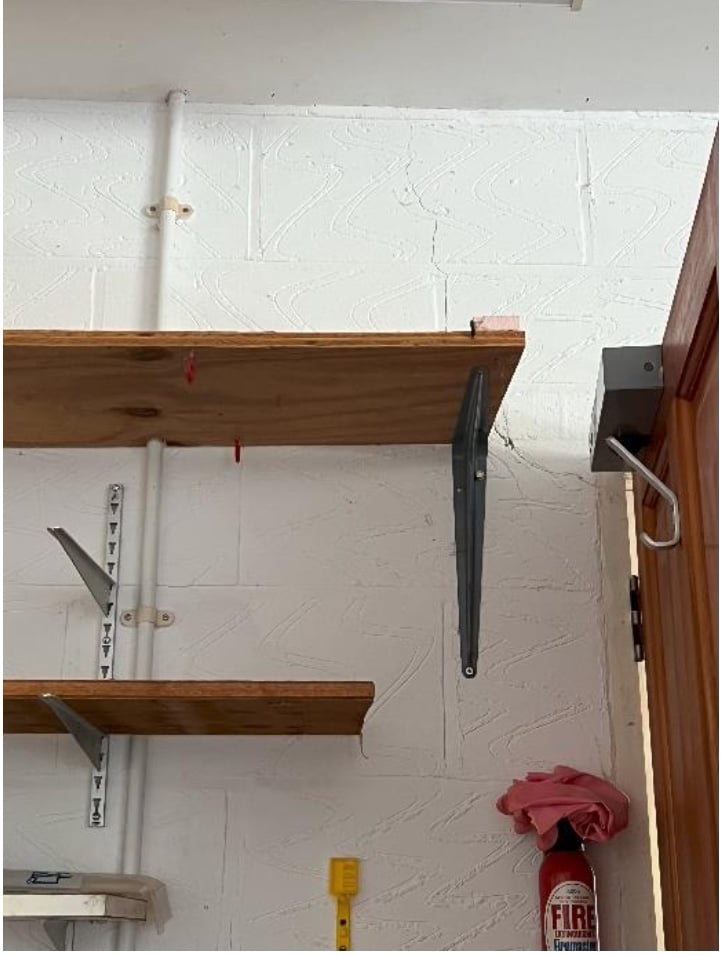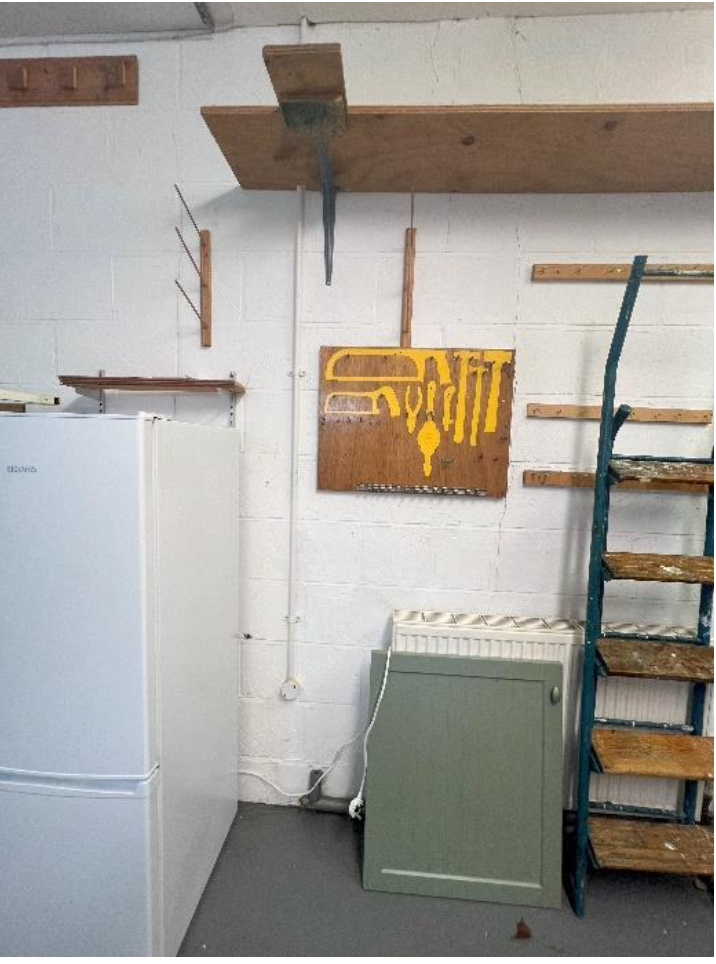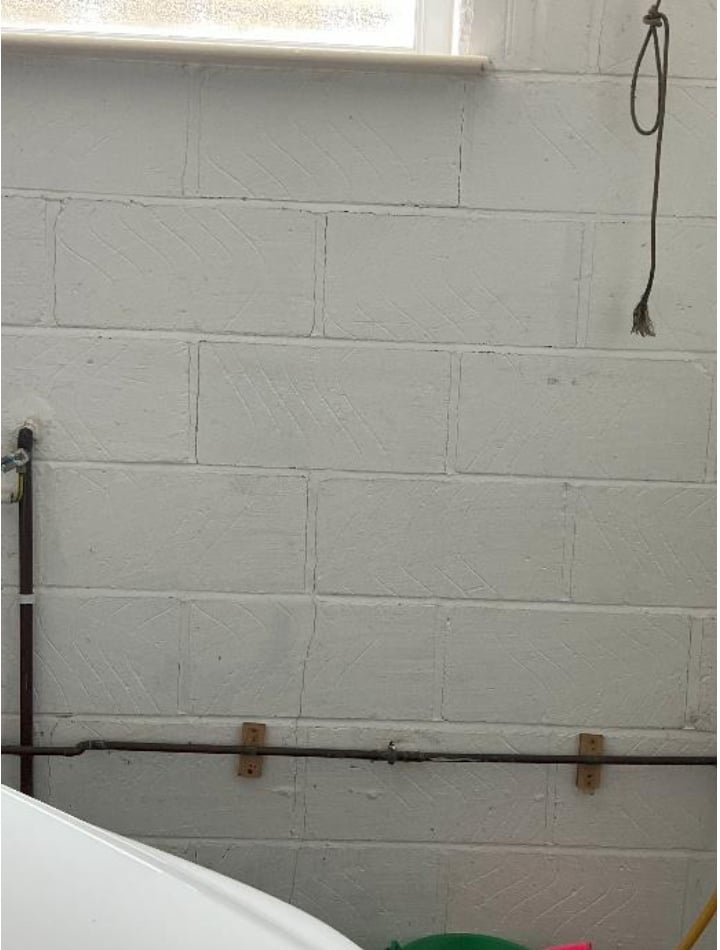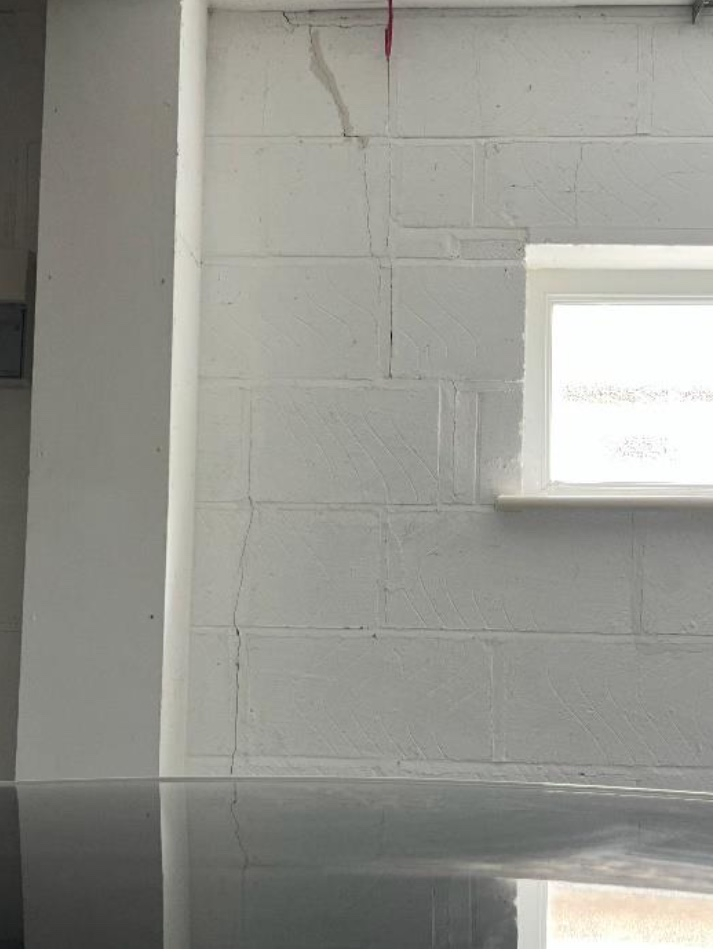We’d like to remind Forumites to please avoid political debate on the Forum.
This is to keep it a safe and useful space for MoneySaving discussions. Threads that are – or become – political in nature may be removed in line with the Forum’s rules. Thank you for your understanding.
buying a house with no movement joints

Comments
-
Normally I would say buy and fix but thinking of what’s required in this case I think I would be inclined to walk away and find something else or be looking to get a very big discount.1
-
These are the cracks that we can see.




0 -
If the cracks are inside the garage and it's a cavity wall, especially if built with AAC blocks, then it's unlikely to be thermal cracking. These type of blocks are well known for shrinkage cracking when first built.
In general, clay bricks at at their smallest when first built and expand as they absorb water.
Blocks are at their largest when first laid, as they are wet, and shrink as they dry out. The shrinkage should have stopped by now after 21 years, as the cracks usually start once the roof is on.
It's never been seen as a serious issue, although some builders choose not to use AAC blocks now.
I've found that by using a weaker mix, with lime added, the cracking isn't usually an issue.
Some people get a Helefix repair, which is even DIY able, although most people don't bother.
I wouldn't be put off a house myself by shrinkage cracks, although you could try for a discount. Loads of houses built have got them, it's just that the dot and dab plasterboard hides them.3 -
I didn't see the photos first time I posted. They are Thermalite blocks, which are probably the most common types to crack, although it might be a bit unfair to slate them as they are probably the most commonly used.
I wouldn't be too concerned about shrinkage cracks in Thermalite block. You could google it to put your mind at rest.2 -
-
It would not put me off buying if the rest of the house fits my needs.
Certainly ask for a bit off to get it sorted, which could just be a skim over so it's not visible.
Only my opinion.
1 -
Think hard,
Possibly talk to a neighbour if possible.
Think about when the time comes to sell it.
Personally, I'd look somewhere else but then others may have
more knowledgeable or risk-averse that may go for it.
If you ask the EA, trust me, they don't want to lose any sale, therefore, do your own investigation and decide.
1 -
cairomick said:We are buying a 21 years ol house with a very large integral garage (sits beneath 3 bedrooms of the house). There are several floor to ceiling horizontal cracks in teh blockwork. in three different walls. Structural engineer report says due to thermal expansion and that the house was built without movement joints and the cracks are due to thermal expansion. Recommends repairs but likely the cracks will return and would need ties etc (sounds like retrospective movement joint fitting).....Did the SE say more about the use of movement joints, and the lack of them in this property?Generally you don't often see movement joints in houses - as a rough guide you need a movement joint in a wall exceeding about 10 to 15m in facing brick, and about 6m in aerated blocks. Typically only in the outer leaf of a cavity wall, or where excessive movement in one wall could impose horizontal loads on a perpendicular wall.So on the average (detached/semi) house, the length of walls wouldn't normally be enough that movement joints were needed. On a terrace there might be a movement joint between two properties, but less commonly within one property.So does the SE think that movement joints should have been provided (given the wall lengths/layout)?1
-
the SESection62 said:cairomick said:We are buying a 21 years ol house with a very large integral garage (sits beneath 3 bedrooms of the house). There are several floor to ceiling horizontal cracks in teh blockwork. in three different walls. Structural engineer report says due to thermal expansion and that the house was built without movement joints and the cracks are due to thermal expansion. Recommends repairs but likely the cracks will return and would need ties etc (sounds like retrospective movement joint fitting).....Did the SE say more about the use of movement joints, and the lack of them in this property?Generally you don't often see movement joints in houses - as a rough guide you need a movement joint in a wall exceeding about 10 to 15m in facing brick, and about 6m in aerated blocks. Typically only in the outer leaf of a cavity wall, or where excessive movement in one wall could impose horizontal loads on a perpendicular wall.So on the average (detached/semi) house, the length of walls wouldn't normally be enough that movement joints were needed. On a terrace there might be a movement joint between two properties, but less commonly within one property.So does the SE think that movement joints should have been provided (given the wall lengths/layout)?
" The cracking present within the garage structure is again a result of thermal expansion andcontraction of the building fabric. Lightweight thermal blocks have been used in the
construction of the property. These types of block are highly susceptible to cracking, with
cracks generally manifesting adjacent/around openings.
Movement joints are recommended within blockwork walls where the panel length exceeds 6m
in length and a joint should be provided within 3m of a return. It is quite common place for
joints not to be provided within residential properties as they can be ‘unsightly’
. The garage walls are of a length to fall within the above criteria. Whilst joints have not been provided, the
cracking noted in the walls is of longstanding and likely to have occurred shortly after the
construction of the property.
Making good should be completed by localised re-pointing of blocks and replacement of any
damaged blocks with new of a similar format. We would advise that thermal movement is
cyclic and therefore the reoccurrence of cracks in the future is possible. If the reappearance of
cracking becomes unacceptable visually, then a proprietary joint can be installed. This will
involve forming a 10mm wide gap in the wall, providing ties at 450mm vertical centres and
then providing a foam backer with a mastic cover joint. The mastic can be coloured to suit the
wall fabric."
1 -
I'd tend to summarise the above as something of a "Don't worry about it" assessment.cairomick said:
the SESection62 said:cairomick said:We are buying a 21 years ol house with a very large integral garage (sits beneath 3 bedrooms of the house). There are several floor to ceiling horizontal cracks in teh blockwork. in three different walls. Structural engineer report says due to thermal expansion and that the house was built without movement joints and the cracks are due to thermal expansion. Recommends repairs but likely the cracks will return and would need ties etc (sounds like retrospective movement joint fitting).....Did the SE say more about the use of movement joints, and the lack of them in this property?Generally you don't often see movement joints in houses - as a rough guide you need a movement joint in a wall exceeding about 10 to 15m in facing brick, and about 6m in aerated blocks. Typically only in the outer leaf of a cavity wall, or where excessive movement in one wall could impose horizontal loads on a perpendicular wall.So on the average (detached/semi) house, the length of walls wouldn't normally be enough that movement joints were needed. On a terrace there might be a movement joint between two properties, but less commonly within one property.So does the SE think that movement joints should have been provided (given the wall lengths/layout)?
" The cracking present within the garage structure is again a result of thermal expansion andcontraction of the building fabric. Lightweight thermal blocks have been used in the
construction of the property. These types of block are highly susceptible to cracking, with
cracks generally manifesting adjacent/around openings.
Movement joints are recommended within blockwork walls where the panel length exceeds 6m
in length and a joint should be provided within 3m of a return. It is quite common place for
joints not to be provided within residential properties as they can be ‘unsightly’
. The garage walls are of a length to fall within the above criteria. Whilst joints have not been provided, the
cracking noted in the walls is of longstanding and likely to have occurred shortly after the
construction of the property.
Making good should be completed by localised re-pointing of blocks and replacement of any
damaged blocks with new of a similar format. We would advise that thermal movement is
cyclic and therefore the reoccurrence of cracks in the future is possible. If the reappearance of
cracking becomes unacceptable visually, then a proprietary joint can be installed. This will
involve forming a 10mm wide gap in the wall, providing ties at 450mm vertical centres and
then providing a foam backer with a mastic cover joint. The mastic can be coloured to suit the
wall fabric."
1
Confirm your email address to Create Threads and Reply

Categories
- All Categories
- 352.2K Banking & Borrowing
- 253.6K Reduce Debt & Boost Income
- 454.3K Spending & Discounts
- 245.3K Work, Benefits & Business
- 601K Mortgages, Homes & Bills
- 177.5K Life & Family
- 259.1K Travel & Transport
- 1.5M Hobbies & Leisure
- 16K Discuss & Feedback
- 37.7K Read-Only Boards





